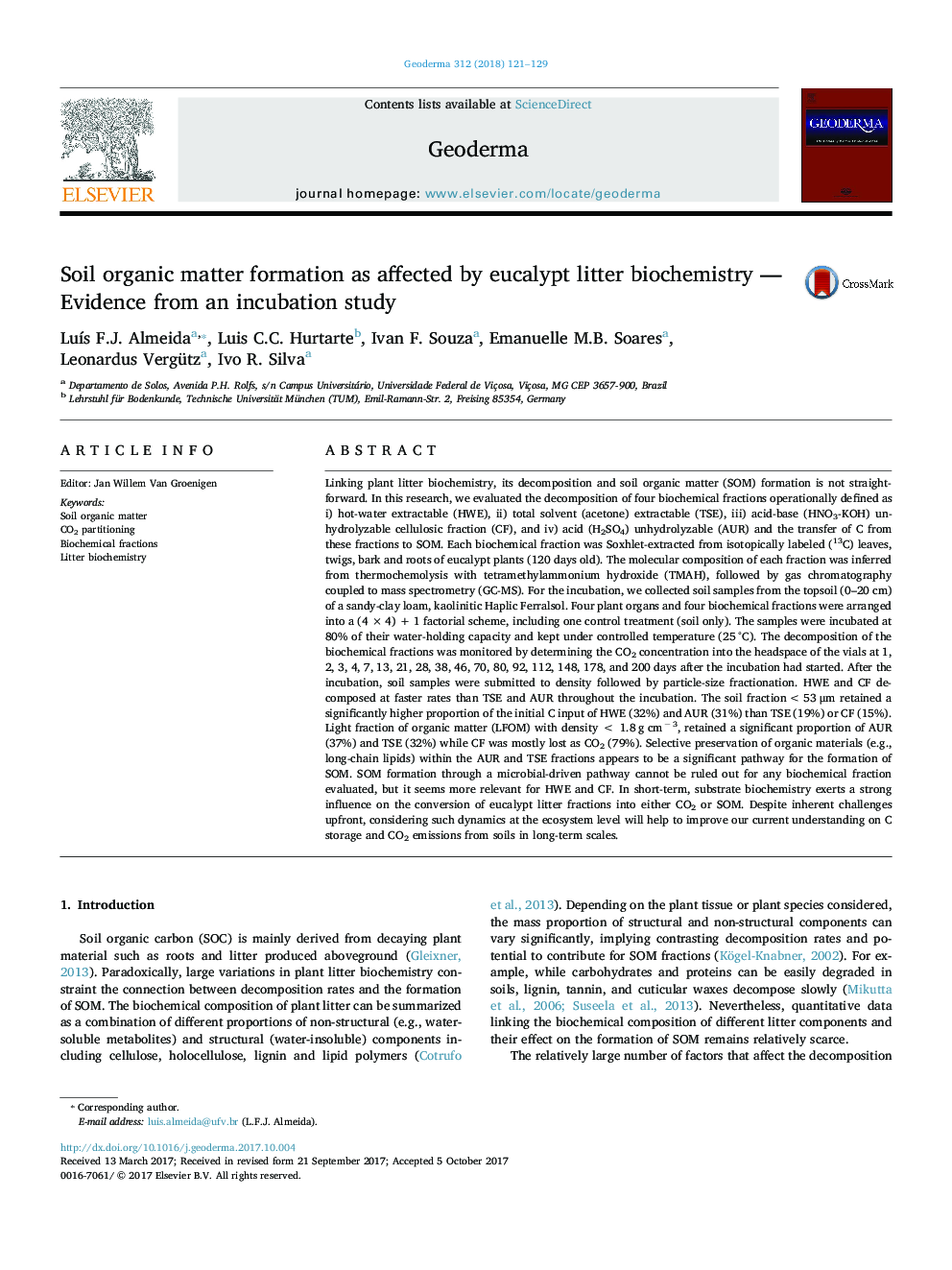| کد مقاله | کد نشریه | سال انتشار | مقاله انگلیسی | نسخه تمام متن |
|---|---|---|---|---|
| 8894373 | 1629405 | 2018 | 9 صفحه PDF | دانلود رایگان |
عنوان انگلیسی مقاله ISI
Soil organic matter formation as affected by eucalypt litter biochemistry - Evidence from an incubation study
ترجمه فارسی عنوان
شکل گیری ماده آلی خاک به عنوان تحت تاثیر بیوشیمی بستر اکتیلیپت - شواهد از مطالعه
دانلود مقاله + سفارش ترجمه
دانلود مقاله ISI انگلیسی
رایگان برای ایرانیان
کلمات کلیدی
ماده آلی خاک، جداسازی دی اکسید کربن، فراکسیون های بیوشیمیایی، بیوشیمی مایع
موضوعات مرتبط
مهندسی و علوم پایه
علوم زمین و سیارات
فرآیندهای سطح زمین
چکیده انگلیسی
Linking plant litter biochemistry, its decomposition and soil organic matter (SOM) formation is not straightforward. In this research, we evaluated the decomposition of four biochemical fractions operationally defined as i) hot-water extractable (HWE), ii) total solvent (acetone) extractable (TSE), iii) acid-base (HNO3-KOH) unhydrolyzable cellulosic fraction (CF), and iv) acid (H2SO4) unhydrolyzable (AUR) and the transfer of C from these fractions to SOM. Each biochemical fraction was Soxhlet-extracted from isotopically labeled (13C) leaves, twigs, bark and roots of eucalypt plants (120 days old). The molecular composition of each fraction was inferred from thermochemolysis with tetramethylammonium hydroxide (TMAH), followed by gas chromatography coupled to mass spectrometry (GC-MS). For the incubation, we collected soil samples from the topsoil (0-20 cm) of a sandy-clay loam, kaolinitic Haplic Ferralsol. Four plant organs and four biochemical fractions were arranged into a (4 Ã 4) + 1 factorial scheme, including one control treatment (soil only). The samples were incubated at 80% of their water-holding capacity and kept under controlled temperature (25 °C). The decomposition of the biochemical fractions was monitored by determining the CO2 concentration into the headspace of the vials at 1, 2, 3, 4, 7, 13, 21, 28, 38, 46, 70, 80, 92, 112, 148, 178, and 200 days after the incubation had started. After the incubation, soil samples were submitted to density followed by particle-size fractionation. HWE and CF decomposed at faster rates than TSE and AUR throughout the incubation. The soil fraction < 53 μm retained a significantly higher proportion of the initial C input of HWE (32%) and AUR (31%) than TSE (19%) or CF (15%). Light fraction of organic matter (LFOM) with density < 1.8 g cmâ 3, retained a significant proportion of AUR (37%) and TSE (32%) while CF was mostly lost as CO2 (79%). Selective preservation of organic materials (e.g., long-chain lipids) within the AUR and TSE fractions appears to be a significant pathway for the formation of SOM. SOM formation through a microbial-driven pathway cannot be ruled out for any biochemical fraction evaluated, but it seems more relevant for HWE and CF. In short-term, substrate biochemistry exerts a strong influence on the conversion of eucalypt litter fractions into either CO2 or SOM. Despite inherent challenges upfront, considering such dynamics at the ecosystem level will help to improve our current understanding on C storage and CO2 emissions from soils in long-term scales.
ناشر
Database: Elsevier - ScienceDirect (ساینس دایرکت)
Journal: Geoderma - Volume 312, 15 February 2018, Pages 121-129
Journal: Geoderma - Volume 312, 15 February 2018, Pages 121-129
نویسندگان
LuÃs F.J. Almeida, Luis C.C. Hurtarte, Ivan F. Souza, Emanuelle M.B. Soares, Leonardus Vergütz, Ivo R. Silva,
